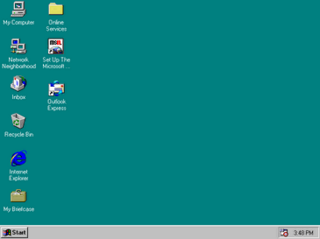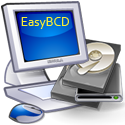
Disk partitioning or disk slicing is the creation of one or more regions on secondary storage, so that each region can be managed separately. These regions are called partitions. It is typically the first step of preparing a newly installed disk, before any file system is created. The disk stores the information about the partitions' locations and sizes in an area known as the partition table that the operating system reads before any other part of the disk. Each partition then appears to the operating system as a distinct "logical" disk that uses part of the actual disk. System administrators use a program called a partition editor to create, resize, delete, and manipulate the partitions.. Partitioning allows the use of different filesystems to be installed for different kinds of files. Separating user data from system data can prevent the system partition from becoming full and rendering the system unusable. Partitioning can also make backing up easier. A disadvantage is that it can be difficult to properly size partitions resulting in having one partition with much free space and another nearly totally allocated.
NTLDR is the boot loader for all releases of Windows NT operating system up to and including Windows XP and Windows Server 2003. NTLDR is typically run from the primary hard disk drive, but it can also run from portable storage devices such as a CD-ROM, USB flash drive, or floppy disk. NTLDR can also load a non NT-based operating system given the appropriate boot sector in a file.

A live CD is a complete bootable computer installation including operating system which runs directly from a CD-ROM or similar storage device into a computer's memory, rather than loading from a hard disk drive. A Live CD allows users to run an operating system for any purpose without installing it or making any changes to the computer's configuration. Live CDs can run on a computer without secondary storage, such as a hard disk drive, or with a corrupted hard disk drive or file system, allowing data recovery.

Windows 9x is a generic term referring to a series of Microsoft Windows computer operating systems produced from 1995 to 2000, which were based on the Windows 95 kernel and its underlying foundation of MS-DOS, both of which were updated in subsequent versions. This includes all versions of Windows 95 and Windows 98. Windows ME is sometimes included.

Multi-booting is the act of installing multiple operating systems on a computer, and being able to choose which one to boot. The term dual-booting refers to the common configuration of specifically two operating systems. Multi-booting may require a custom boot loader.
Disk cloning is the process of copying the contents of one computer hard disk to another disk or to an "image" file. This may be done straight from one disk to another, but more often, the contents of the first disk are written to an image file as an intermediate step, then the second disk is loaded with the contents of the image. Typically, this is done for archiving purposes, to restore lost or damaged data, or to move wanted data into a new disk, though other reasons also exist.

A diskless node is a workstation or personal computer without disk drives, which employs network booting to load its operating system from a server.
The Windows Imaging Format (WIM) is a file-based disk image format. It was developed by Microsoft to help deploy Windows Vista and subsequent versions of Windows operating system family, as well as Windows Fundamentals for Legacy PCs.
The Windows NT startup process is the process by which Windows NT 4.0, Windows 2000, Windows XP and Windows Server 2003 operating systems initialize. In Windows Vista and later, this process has changed significantly; see Windows Vista startup process for information about what has changed.

The Recovery Console is a feature of the Windows 2000, Windows XP and Windows Server 2003 operating systems. It provides the means for administrators to perform a limited range of tasks using a command line interface. Its primary function is to enable administrators to recover from situations where Windows does not boot as far as presenting its graphical user interface. The recovery console is used to provide a way to access the hard drive in an emergency through the command prompt. As such, the Recovery Console can be accessed either through the original installation media used to install Windows, or it can also be installed to the hard drive and added to the NTLDR menu, however, relying on the latter is more risky because it requires that the computer can boot to the point that NTLDR loads.
The startup process of Windows Vista, Windows Server 2008 and their successors differs from the startup process part of previous versions of Windows.
Windows Vista contains a range of new technologies and features that are intended to help network administrators and power users better manage their systems. Notable changes include a complete replacement of the "Windows Setup" process, completely rewritten deployment mechanisms, support for per-application Remote Desktop sessions, new diagnostic and health monitoring tools, and a range of new Group Policy settings covering many of the features new to Windows Vista.
Windows Deployment Services is a server technology from Microsoft for network-based installation of Windows operating systems. It is the successor to Remote Installation Services. WDS is intended to be used for remotely deploying Windows Vista, Windows 7, Windows 8, Windows 10, Windows Server 2008, Windows Server 2012 and Windows Server 2016, but also supports other operating systems because unlike its predecessor RIS, which was a method of automating the installation process, WDS uses disk imaging, in particular the Windows Imaging Format (WIM). WDS is included as a Server Role in all 32-bit and 64-bit versions of Windows Server 2008, and is included as an optionally installable component with Windows Server 2003 Service Pack 2.
VHD is a file format which represents a virtual hard disk drive (HDD). It may contain what is found on a physical HDD, such as disk partitions and a file system, which in turn can contain files and folders. It is typically used as the hard disk of a virtual machine.

EasyBCD is a program developed by NeoSmart Technologies to configure and tweak the Boot Configuration Data (BCD), a boot database first introduced in Windows Vista and used in all subsequent Windows releases. EasyBCD can be used to set up multi-boot environments for computers on which some versions of Windows, Linux, BSD and Mac OS X can be simultaneously installed; EasyBCD can also be used for adding entries to bootable tools and utilities, as well as modifying and controlling the behavior of the Windows boot menu. EasyBCD 2.3 introduced additional support for creating and managing entries for UEFI-based Windows entries in the boot menu. As of June 20, 2011 with the release of EasyBCD 2.1, it is no longer free for use in commercial environments which require the purchase of a paid license, however it remains free for home and non-profit use without limitations.
In computing, diskpart is a command-line disk partitioning utility included in Windows 2000 and later, replacing its predecessor, fdisk.
Side-by-side assembly technology is a standard for executable files in Windows 98 Second Edition, Windows 2000, and later versions of Windows that attempts to alleviate problems that arise from the use of dynamic-link libraries (DLLs) in Microsoft Windows. Such problems include version conflicts, missing DLLs, duplicate DLLs, and incorrect or missing registration. In side-by-side, Windows stores multiple versions of a DLL in the WinSxS subdirectory of the Windows directory, and loads them on demand. This reduces dependency problems for applications that include a side-by-side manifest.

The architecture of the Windows 9x series kernel is monolithic. The basic code is considered similar in function to MS-DOS. As a 16-/32-bit hybrid, it requires MS-DOS support to operate.











